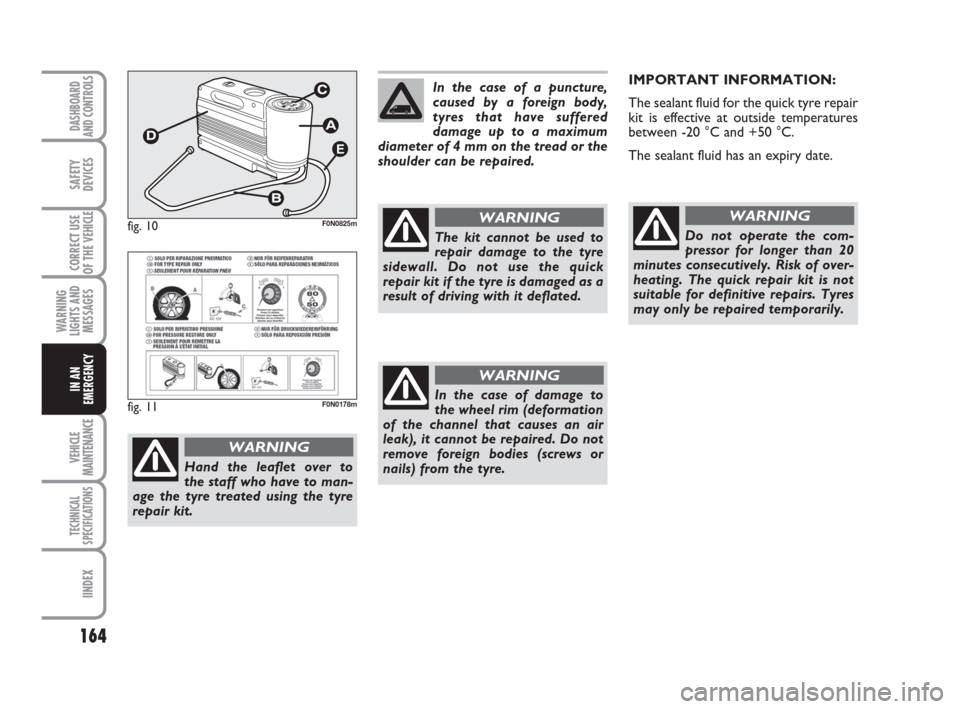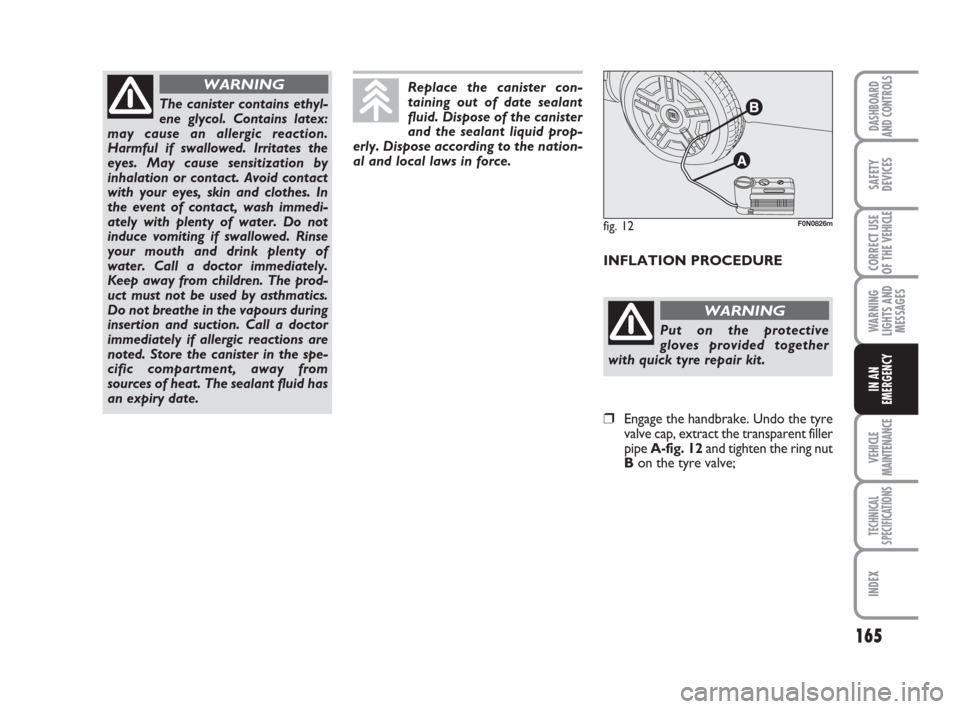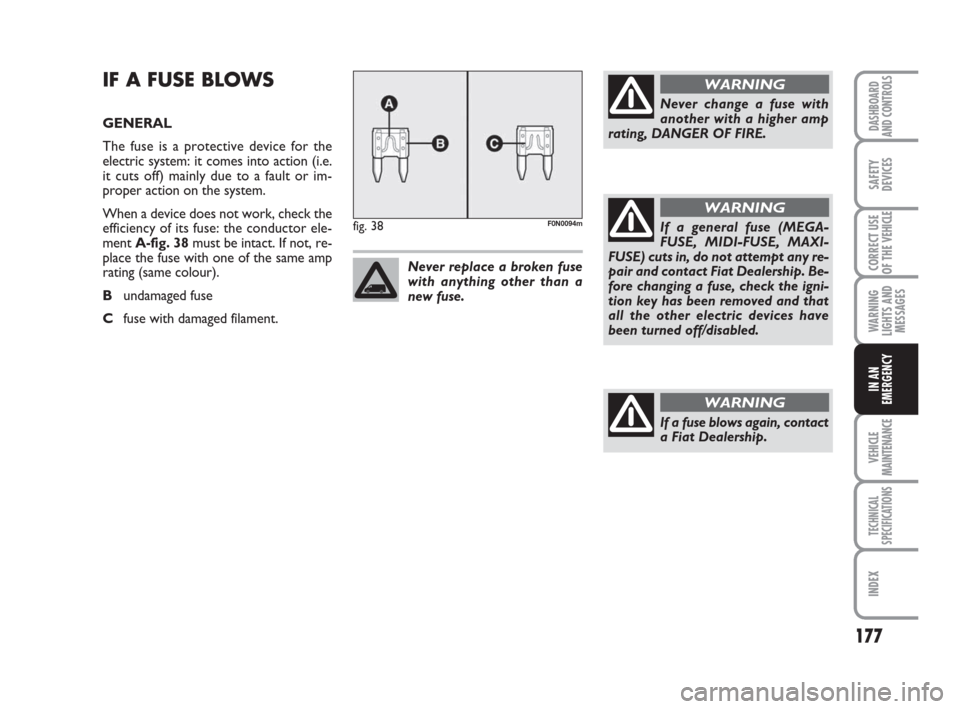2009 FIAT DUCATO air con
[x] Cancel search: air conPage 165 of 282

164
WARNING
LIGHTS AND
MESSAGES
VEHICLE
MAINTENANCE
TECHNICAL
SPECIFICATIONS
IINDEX
DASHBOARD
AND CONTROLS
SAFETY
DEVICES
CORRECT USE
OF THE
VEHICLE
IN AN
EMERGENCY
IMPORTANT INFORMATION:
The sealant fluid for the quick tyre repair
kit is effective at outside temperatures
between -20 °C and +50 °C.
The sealant fluid has an expiry date.
Do not operate the com-
pressor for longer than 20
minutes consecutively. Risk of over-
heating. The quick repair kit is not
suitable for definitive repairs. Tyres
may only be repaired temporarily.
WARNING
In the case of a puncture,
caused by a foreign body,
tyres that have suffered
damage up to a maximum
diameter of 4 mm on the tread or the
shoulder can be repaired.
The kit cannot be used to
repair damage to the tyre
sidewall. Do not use the quick
repair kit if the tyre is damaged as a
result of driving with it deflated.
WARNING
In the case of damage to
the wheel rim (deformation
of the channel that causes an air
leak), it cannot be repaired. Do not
remove foreign bodies (screws or
nails) from the tyre.
WARNING
fig. 11F0N0178m
Hand the leaflet over to
the staff who have to man-
age the tyre treated using the tyre
repair kit.
WARNING
fig. 10
E
F0N0825m
Page 166 of 282

165
WARNING
LIGHTS AND
MESSAGES
VEHICLE
MAINTENANCE
TECHNICAL
SPECIFICATIONS
INDEX
DASHBOARD
AND CONTROLS
SAFETY
DEVICES
CORRECT USE
OF THE
VEHICLE
IN AN
EMERGENCY
The canister contains ethyl-
ene glycol. Contains latex:
may cause an allergic reaction.
Harmful if swallowed. Irritates the
eyes. May cause sensitization by
inhalation or contact. Avoid contact
with your eyes, skin and clothes. In
the event of contact, wash immedi-
ately with plenty of water. Do not
induce vomiting if swallowed. Rinse
your mouth and drink plenty of
water. Call a doctor immediately.
Keep away from children. The prod-
uct must not be used by asthmatics.
Do not breathe in the vapours during
insertion and suction. Call a doctor
immediately if allergic reactions are
noted. Store the canister in the spe-
cific compartment, away from
sources of heat. The sealant fluid has
an expiry date.
WARNINGReplace the canister con-
taining out of date sealant
fluid. Dispose of the canister
and the sealant liquid prop-
erly. Dispose according to the nation-
al and local laws in force.
Put on the protective
gloves provided together
with quick tyre repair kit.
WARNING
❒Engage the handbrake. Undo the tyre
valve cap, extract the transparent filler
pipe A-fig. 12and tighten the ring nut
Bon the tyre valve;
fig. 12F0N0826m
INFLATION PROCEDURE
Page 167 of 282

166
WARNING
LIGHTS AND
MESSAGES
VEHICLE
MAINTENANCE
TECHNICAL
SPECIFICATIONS
IINDEX
DASHBOARD
AND CONTROLS
SAFETY
DEVICES
CORRECT USE
OF THE
VEHICLE
IN AN
EMERGENCY
❒insert the pin E-fig. 14in the near-
est 12V current socket and start the
engine. Turn the selector D-fig. 13
anti-clockwise to the repair position.
Activate the kit by pressing the
on/off switch. Inflate the tyre to the
pressure specified in the “Inflation
pressure” paragraph, in the “Technical
Data” chapter.For a more accurate reading, it is
advisable to check the pressure
reading on the pressure gauge F-
fig. 13with the compressor off and
without moving the centre selector
from the repair position;
❒if a pressure of at least 3 bar is not
reached within 10 minutes, detach
the transparent filler pipe from the
valve and switch off the 12V current
pin, then move the vehicle about 10
metres forward to distribute the
sealant liquid inside the tyre and
repeat the inflation operation;
❒if, in this case too, within 10 minutes
of turning the compressor on, a
pressure of at least 3 bar is not
reached, do not start driving again
because the tyre is too damaged and
the quick repair kit is not sufficient in
this situation and it is necessary to
go to a Fiat Dealership;
❒if the tyre reaches the pressure spec-
ified in “Inflation pressure” pressure
in the “Technical Data” chapter,
start driving immediately;
fig. 13F0N0827m
fig. 14F0N0182m
Apply the adhesive label in a
position clearly visible by the
driver as a reminder that the tyre has
been treated with the quick repair
kit. Drive carefully, particularly on
bends. Do not exceed 80 km/h. Do
not accelerate or brake suddenly.
WARNING
❒after driving for about 10 minutes,
stop and check the tyre pressure
again; remember to engage the
handbrake;
❒if, on the other hand, a pressure of at
least 3 bar is reached, restore the cor-
rect pressure recommended in the
“Tyre inflation” paragraph in the
“Technical Data” chapter (with engine
running and handbrake on) and
resume driving;
Stop if the pressure has
dropped to less than 3 bar:
The automatic Fix & Go fast repair
kit cannot work properly if the tyre
is excessively damaged. Go to a Fiat
Dealership.
WARNING
Page 168 of 282

167
WARNING
LIGHTS AND
MESSAGES
VEHICLE
MAINTENANCE
TECHNICAL
SPECIFICATIONS
INDEX
DASHBOARD
AND CONTROLS
SAFETY
DEVICES
CORRECT USE
OF THE
VEHICLE
IN AN
EMERGENCY
❒drive with the utmost care to the
nearest Fiat Dealership.
FOR CHECKING AND
RESTORING PRESSURE ONLY
The compressor may also be used for
restoring pressure only.
❒Engage the handbrake
❒Undo the cap for the tyre valve, extract
the black pipe and tighten the ring nut
on the tyre valve.
❒Insert the pin in the nearest 12V cur-
rent socket and start the engine.
❒Rotate the selector clockwise to the
pressure renewal position.
❒Activate the kit by pressing the
on/off switch. Inflate the tyre to the
pressure specified in the “Inflation
pressure” paragraph, in the
“Technical Data” chapter.
NOTE If the tyre has to be deflated,
press the dedicated button Billustrated
in fig. 16.
For a more accurate reading, it is advis-
able to check the pressure reading on the
pressure gauge with the compressor off
and without moving the centre selector
from the repair position.CANISTER REPLACEMENT
PROCEDURE
To replace the canister, proceed as fol-
lows:
❒push button A-fig. 17to release the
replacement part;
❒fit the new cansiter and press until it
is automatically engaged.
❒fit the new cylinder and turn it
clockwise;
❒fit connection Aand connect tube
Binto its seat.
Remember to inform the
workshop that the tyre has
been treated with a quick repair kit.
Hand the leaflet over to the staff
who will be dealing the the tyre
treated using the tyre repair kit.
WARNING
If different tyres from the
ones supplied with the vehi-
cle are used, the repair cannot be
carried out. If the tyres are being
changed, it is advisable to used ones
approved by the manufacturer.
Consult a Fiat Dealership.
WARNING
fig. 16
B
F0N0830m
fig. 17F0N0829m
fig. 15F0N0828m
Page 169 of 282

168
WARNING
LIGHTS AND
MESSAGES
VEHICLE
MAINTENANCE
TECHNICAL
SPECIFICATIONS
IINDEX
DASHBOARD
AND CONTROLS
SAFETY
DEVICES
CORRECT USE
OF THE
VEHICLE
IN AN
EMERGENCY
WHEN NEEDING TO
CHANGE A BULB
GENERAL INSTRUCTIONS
❒When a light is not working, check
that the corresponding fuse is intact
before changing a bulb. For the loca-
tion of fuses, refer to the paragraph “If
a fuse blows” in this section;
❒Before changing a bulb check the con-
tacts for oxidation;
❒Burnt bulbs must be replaced by oth-
ers of the same type and power;
❒Always check the height of the head-
light beam after changing a bulb.
IMPORTANT The headlight inner surface
may be lightly misted over: this is not a
fault but a natural fact due to low tem-
perature and the level of air humidity. It
will disappear as soon the headlights are
turned on. The presence of drops inside
the headlights means water infiltration,
therefore contact Fiat Dealership.
TYPES OF BULBS
Various types of bulbs are fitted to your
vehicle:
AGlass bulbs: clipped into position. Pull
to remove.BBayonet type bulbs: to remove this
type of bulb from its holder, press the
bulb and turn it counter-clockwise.
CTubular bulbs: release them from
their contacts to remove.
D-EHalogen bulbs: to remove the bulb,
release the clip holding the bulb in
place. Halogen bulbs must be han-
dled touching only the metal-
lic part. If the transparent bulb
is touched with the fingers, its
lighting intensity is reduced and life of
the bulb may be compromised. If
touched accidentally, rub the bulb with
a cloth moistened with alcohol and al-
low to dry.
Modifications or repairs to
the electrical system (elec-
tronic control units) carried out in-
correctly and without bearing the fea-
tures of the system in mind can cause
malfunctions with the risk of fire.
WARNING
Halogen bulbs contain pres-
surised gas which, if broken,
may cause small fragments of glass to
be projected outwards.
WARNING
fig. 18F0N0078m
Page 178 of 282

177
WARNING
LIGHTS AND
MESSAGES
VEHICLE
MAINTENANCE
TECHNICAL
SPECIFICATIONS
INDEX
DASHBOARD
AND CONTROLS
SAFETY
DEVICES
CORRECT USE
OF THE
VEHICLE
IN AN
EMERGENCY
IF A FUSE BLOWS
GENERAL
The fuse is a protective device for the
electric system: it comes into action (i.e.
it cuts off) mainly due to a fault or im-
proper action on the system.
When a device does not work, check the
efficiency of its fuse: the conductor ele-
ment A-fig. 38must be intact. If not, re-
place the fuse with one of the same amp
rating (same colour).
Bundamaged fuse
Cfuse with damaged filament.
fig. 38F0N0094m
Never change a fuse with
another with a higher amp
rating, DANGER OF FIRE.
WARNING
Never replace a broken fuse
with anything other than a
new fuse.
If a general fuse (MEGA-
FUSE, MIDI-FUSE, MAXI-
FUSE) cuts in, do not attempt any re-
pair and contact Fiat Dealership. Be-
fore changing a fuse, check the igni-
tion key has been removed and that
all the other electric devices have
been turned off/disabled.
WARNING
If a fuse blows again, contact
a Fiat Dealership.
WARNING
Page 183 of 282

182
WARNING
LIGHTS AND
MESSAGES
VEHICLE
MAINTENANCE
TECHNICAL
SPECIFICATIONS
IINDEX
DASHBOARD
AND CONTROLS
SAFETY
DEVICES
CORRECT USE
OF THE
VEHICLE
IN AN
EMERGENCY
USERSFUSE AMPERE
Control on driver’s door, Controls on passenger’s door F45 7.5
AbsentF46 –
Driver’s power window F47 20
Passenger’s power window F48 20
Sound System, Driver’s power window, Dashboard controls,
Alarm control unit, Rain sensor (+key) F49 7.5
Airbag (+key)F50 7.5
A/C control, Cruise control, Chronotachograph (+key) F51 7.5
Optional fuse box relay F52 7.5
Instrument panel, Rear fog lights (+battery) F53 7.5
Page 190 of 282

189
WARNING
LIGHTS AND
MESSAGES
TECHNICAL
SPECIFICATIONS
INDEX
DASHBOARD
AND CONTROLS
SAFETY
DEVICES
CORRECT USE
OF THE VEHICLE
IN AN
EMERGENCY
VEHICLE
MAINTENANCE
SCHEDULED SERVICING ................................................ 190
SERVICE SCHEDULE........................................................... 191
ROUTINE MAINTENANCE ............................................. 195
HEAVY-DUTY ...................................................................... 195
CHECKING FLUID LEVELS................................................ 196
AIR FILTER ............................................................................ 202
POLLEN FILTER ................................................................... 202
BATTERY................................................................................ 202
WHEELS AND TYRES......................................................... 205
RUBBER HOSES.................................................................... 206
WINDSCREEN/REAR WINDOW WIPERS................... 206
BODYWORK........................................................................ 208
INTERIORS ............................................................................ 210
VV V
E E
H H
I I
C C
L L
E E
M M
A A
I I
N N
T T
E E
N N
A A
N N
C C
E E